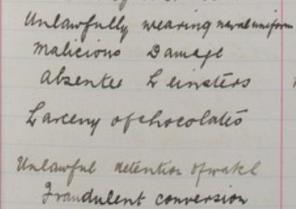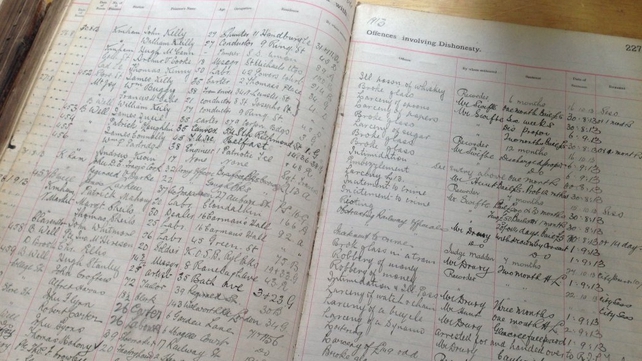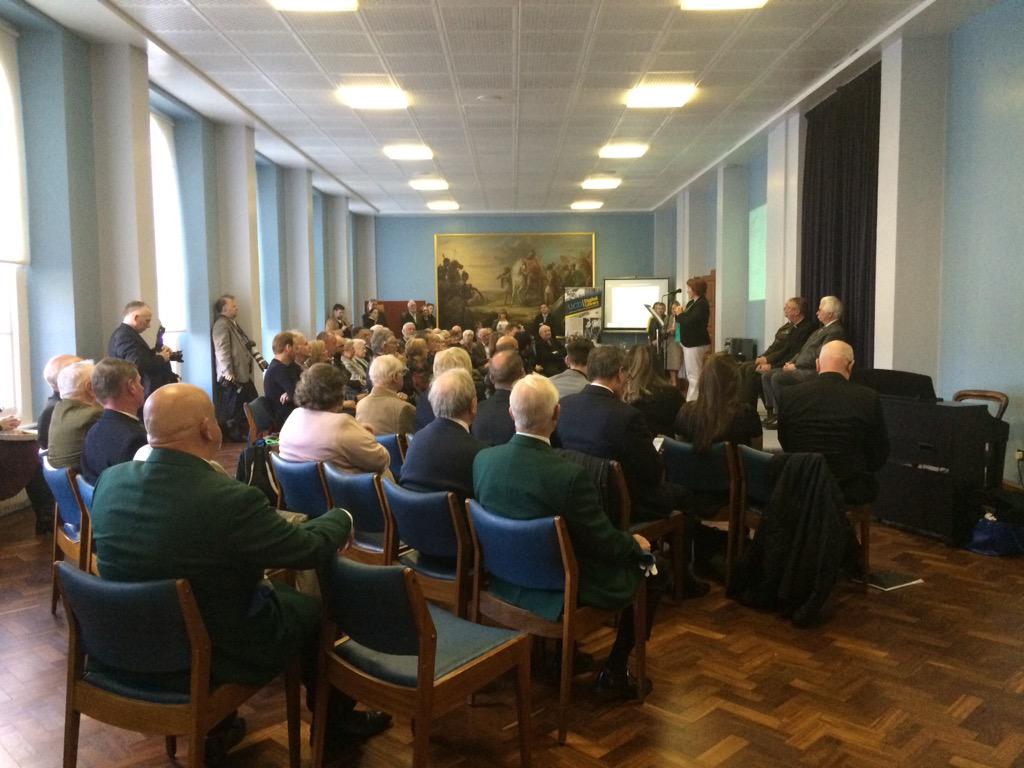‘Loreto 1916’ – A new online exhibition & digital collection. UCD Library Blog https://ucdlib.wordpress.com/2016/11/23/loreto-1916-a-new-online-exhibition-digital-collection/
- Nov 2016
-
digital.ucd.ie digital.ucd.ie
- May 2016
-
digital.ucd.ie digital.ucd.ie
-
"Poverty, manslaughter and stealing apples: police records shed light on Dublin 100 years ago," journal.ie (2015-05-14) http://www.thejournal.ie/police-records-arrests-100-years-ago-dublin-2765946-May2016/

LIFE IN DUBLIN in the early 20th century was tough, especially given the huge class divide. However, it was also a time of remarkable change. Newly-released digitised Dublin Metropolitan Police records show us what life was like from 1905 to 1918. The records cover some of Dublin’s major historical events, including the 1913 Lockout, the 1916 Rising and its aftermath. Over 30,000 people were arrested during this period and these details are all contained in the records.
Sean Lemass' arrest (down as John Lemass) fifth row from the bottom.
-
"Thousands of files containing details of prisoners arrested during 1913 Lockout, Easter Rising published online," RTÉ Six-One News (2016-05-11) [flash video]
RTÉ Six-One News report on the restoration of DMP Prisoners Books to the Garda Museum and Archives, and launch of the four digitised volumes of Dublin Metropolitan Police prisoner books from the Irish revolutionary period.
-
"UCD Library Cultural Heritage: Launch of the Dublin Metropolitan Police Prisoners Books." Flickr (2015-05-11)
Flickr album of photographs from the SPITU-sponsored launch of the digital DMP Prisoners Books at Liberty Hall, Dublin.
-
"SIPTU presents historic DMP files to Garda and to UCD online library" (2016-05-11) http://www.siptu.ie/media/pressreleases2016/featurednews/fullstory_19808_en.html
SIPTU presented ‘Prisoners Books’ concerning over 30,000 people arrested by the Dublin Metropolitan Police (DMP) between 1905 and 1918 to the Garda Síochána at a ceremony in Liberty Hall, Dublin, this morning (11th May).
-
PULSE, 1916. http://www.broadsheet.ie/2016/05/11/fingers-on-the-pulse-of-1916/

The Dublin Metropolitan Police (DMP) Prisoners Books for 1905-1908 and 1911-1918 are amongst the most valuable new documents to come to light on the revolutionary decade.
They include important information on social and political life in the capital during the last years of the Union, from the period of widespread anticipation of Home Rule, to the advent of the 1913 Lockout, the outbreak of the First World War in 1914, the Easter Rising and its aftermath in 1916, and including the conscription crisis of 1918.
They will also be invaluable to those interested in criminology, genealogy, and family history.
The collection comprises of four large leather bound, double ledger volumes containing hand written entries that record the details of daily charge sheets issued by DMP members to offenders or alleged offenders.
Each volume contains the name, age, address, occupation, alleged offence and, in most cases, outcome of cases involving over 30,000 people arrested by the DMP.
Each volume also contains an index of prisoners with references to the pages containing details of the charge. The information in these volumes serves, therefore, to provide new perspectives on life in Dublin during a time of war and revolution.
-
"Discovery of police files opens new chapter on Rising era," Irish Times (2016-05-11) http://www.irishtimes.com/culture/heritage/discovery-of-police-files-opens-new-chapter-on-rising-era-1.2644187
Records found in Clontarf attic detail arrests of Larkin and Connolly during Dublin lockout
-
Dublin Metropolitan Police's Prisoners Books released," Irish Geneology News (2016-05-12) http://www.irishgenealogynews.com/2016/05/dublin-metropolitan-polices-prisoners.html

Launched yesterday at Liberty Hall, these records date from Ireland's revolutionary era and include all manner of crimes listed in register pages headed 'Prisoners charged with offences involving dishonesty'. ...
-
"Historic police records showing Connolly and Larkin arrests found in skip," Irish Independent (2016-05-11) http://www.independent.ie/irish-news/historic-police-records-showing-connolly-and-larkin-arrests-found-in-skip-34707471.html

The four missing volumes of 'Prisoner Books' listing the arrests of more than 30,000 people between 1905 and 1918 include the "crimes" of labour leaders Jim Larkin (seditious conspiracy), James Connolly (incitement to crime), revolutionary Maud Gonne MacBride (defence of the realm) and suffragette Hanna Sheehy Skeffington, (glass-breaking with other suffragettes).
-
"Records of 1916 Rising arrests published online," Irish Examiner (2016-05-12)

Reports containing details of 30,000 arrests by the Dublin Metropolitan Police more than 100 years ago have been published online, writes Dan Buckley.
They contain details of prisoners during the Lockout of 1913, the outbreak of the First World War and the 1916 Easter Rising.
-
"Dublin Metropolitan prisoner books available online," Irish Times (2016-05-11) http://www.rte.ie/news/2016/0511/787671-dublin-metropolitan-prisoners-books/

Dublin Metropolitan Prisoners Books from over 100 years ago containing reports of over 30,000 arrests have been published online.
Tags
- Jack O'Connor
- video
- Jim Larkin
- Garda Museum
- Irish Times
- Nóirín O’Sullivan
- journal.ie
- UCD Library
- Dublin Metropolitan Police
- UCD DIgital Library
- Ros Pan
- flickr
- John Howard
- Hanna Sheehy Skeffington
- Irish Independent
- SIPTU
- dmp
- James Connolly
- UCD
- ucd
- Maud Gonne MacBride
- Prisoners books
- DMP
- UCD Digital Library
- @UCD
- RTÉ Six-One News
- @UCDDigital
Annotators
URL
-
- Apr 2016
-
www.irishtimes.com www.irishtimes.com
-
Poetry for posterity: the Irish Poetry Reading Archive launches
Videos as well as digitised versions of the poets' manuscripts are available at the Irish Poetry Reading Collection on the UCD Digital Library, at https://digital.ucd.ie/view/ucdlib:38488. See also coverage at the UCD Library Blog, https://ucdlib.wordpress.com/2015/12/02/irish-poetry-reading-archive-launches/.

-
-
digital.ucd.ie digital.ucd.ie
-
See the Irish Times coverage of the launch of the Irish Poetry Reading Archive: http://www.irishtimes.com/culture/books/poetry-for-posterity-the-irish-poetry-reading-archive-launches-1.2450480
-
-
www.stillorganchamber.ie www.stillorganchamber.ie
-
Access the collection, Ordnance Survey Ireland (OSi) 19th Century Historical Maps, at https://digital.ucd.ie/view/ucdlib:40377
-
-
digital.ucd.ie digital.ucd.ie
-
See "View large scale 19th century Irish town and city maps," at RootsIreland.ie 2016-03-09.
-
-
digital.ucd.ie digital.ucd.ie
-
See the article by Audrey Drohan covering the Kevin Barry Collection launch and exhibition, at UCD Library Blog.

-
Dairmaid Ferriter's talk from the launch of the Kevin Barry Colleciton is on Soundcloud: https://soundcloud.com/history-hub/diarmaid-ferriter-kevin-barry-and-his-legacy.
 .
.
-
- Jul 2015
-
digital.ucd.ie digital.ucd.ie
-
Dundalk market day, Co. Louth
The Dundalk Market Square web site offers the following history of the Dundalk market:
In the 17th century, Lord Limerick (later James Hamilton, 1st Earl of Clanbrassil) created the modern town we know today. He was responsible for the construction of streets leading to the town centre; his ideas came from many visits to Europe. In addition to the demolition of the old walls and castles, he had new roads laid out eastwards of the principal streets. The most important of these new roads connected a newly laid down Market Square, which still survives, with a linen and cambric factory at its eastern end, adjacent to what was once an army cavalry and artillery barracks (now Aiken Military Barracks).
In the 19th century, the town grew in importance and many industries were set up in the local area. This development was helped considerably by the opening of railways, the expansion of the docks area or 'Quay' and the setting up of a board of commissioners to run the town.
The present photograph was captured by the Coimisiún Béaloideasa Éireann (CBÉ) / Irish Folklore Commission (1935).

-
- May 2015
-
digital.ucd.ie digital.ucd.ie
-
Selected images from the Desmond FitzGerald Photographs collection in UCD Archives were used to illustrate Conor Mulvagh's video presentation, "The Destruction of Dublin, 1916," issued as part of the UCD Decade of Centenaries web site; it is also available on youtube.

-
-
digital.ucd.ie digital.ucd.ie
-
The Fr. Francis A. Gleeson Papers digital collection was officially launched on Monday April 27 by the Archbishop of Dublin, Diarmuid Martin at a reception in Holy Cross Diocesan Centre, in Clonliffe. The event was attended by members of Fr Gleeson’s family as well as the British and French Ambassadors to Ireland and Archbishop Michael Jackson.

For press commentaries on this collection see:
- Decade of Centenaries http://www.decadeofcentenaries.com/27-april-2015-fr-gleeson-digital-archive-launch/
- HistoryHub.ie http://historyhub.ie/fr-francis-gleeson-papers
- The Irish Times http://www.irishtimes.com/news/ireland/irish-news/war-diaries-of-fr-francis-gleeson-go-online-1.2191271
- The Irish Examiner http://www.irishexaminer.com/lifestyle/features/fr-francis-gleeson--the-irish-saint-of-the-trenches-283785.html
- theJournal.ie http://www.thejournal.ie/diary-priest-world-war-one-2073121-May2015/
- Dublin News http://www.dublinnews.com/index.php/sid/232377229
- The Irish Catholic http://www.irishcatholic.ie/article/dublin-diocese-putting-wwi-chaplain%E2%80%99s-diary-online
-
